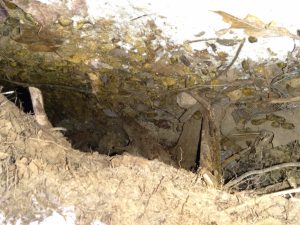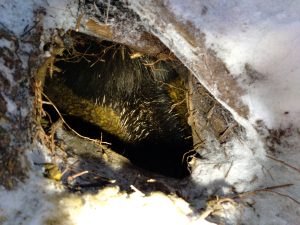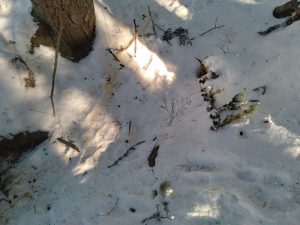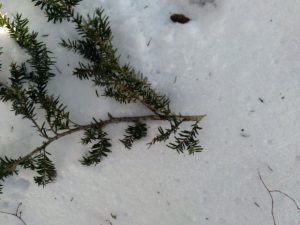Tracking down porcupines
I began learning wildlife tracking some months ago when I realized walking around aimlessly rarely resulted in a good use of my time in eastern US forests. Learning even basic sign of things like moose, black bear, and easily discernable species allowed me to begin finding them with some regularlity near my home. Porcupines are another fairly easy species to locate where I am in the Northeast either by spotting them in trees or by checking out roadsides in spring where they like the salts I presume. Once I was messing with my backpack and one climbed down a tree right behind me. However, I have found an even easier method to locate them which is in winter. They leave unmistakable sign where they are denning and because the fresh snow has covered old feeding sign, you know what you are seeing is recent (they cut branches have 45 degree angles like other rodents), the scat is fairly unique, and the urine/scatt just outside the den also confirms the evidence is recent as we had just had snow. Unfortunately, this method does not result in very nice photos but if someone were truly ambitious I am sure returning to the den area would eventually result in a nice photo of a porcupine in a feeding tree. My next trip will be to Algonquin PP to look for marten in Feb, if anyone should happen to have any tips to look for them, I would appreciate that as well. Unfortunately, my wildlife tracking skills are still pretty limited at this point (and increasing only very, very, very slowly)




‘]
Post author
4 Comments
-
-
PaintedTraveler
It sounds to me like your current methods of winter porcupine tracking are pretty on point. In winter, unlike summer, they rarely move dens and they usually don’t travel very far from their dens to eat so if you locate a den site your odds go up pretty good. Winter is also the only time where they’re likely to den in groups so it is possible to get a few of them in one site.
Fun fact, the spring road gatherings are technically for the road salt but they don’t actually lick it up or anything, they stick to chewing on sticks/logs/wood near the road that has had the salt soak into it which is why you only really get them on the roadways as the snow is melting and the water can help the salt soak in.
Leave a Reply
You must be logged in to post a comment.


Jon Hall
In Algonquin it might be easier to track down trash cans and bird feeders. That’s where the Marten are most likely to be!